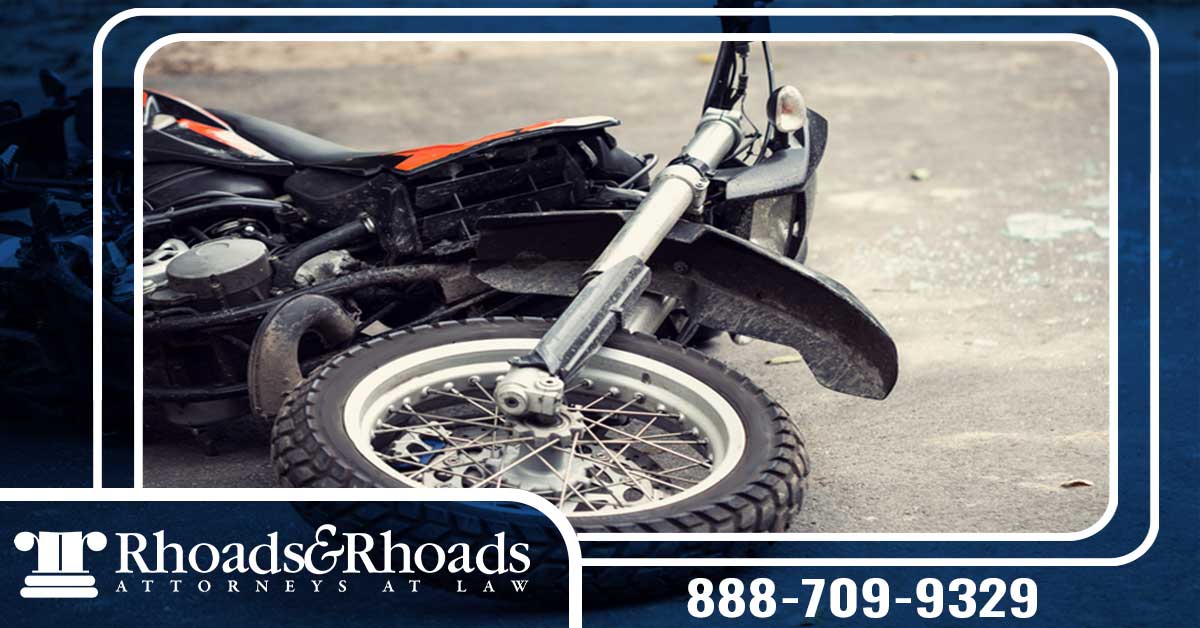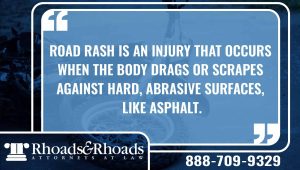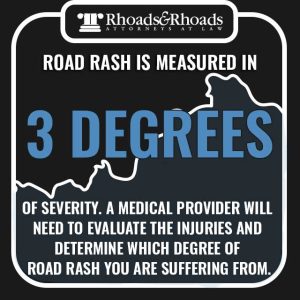
Motorcycle accidents often result in severe injuries and even fatalities. There is always a risk to being on the roads, but motorcycle riders have additional risk because they are less protected in an accident than drivers of cars, vans, trucks, and other motor vehicles.
Although there are many kinds of injuries that you can suffer after a motorcycle accident, one of the most common is road rash. Road rash can happen on any part of the body that contacts the road in a crash, and it can range from mild to severe. Depending on the type of road rash, the layers of skin may be severely damaged.
You may need minor treatment like antibiotic ointments and bandages, or you may need to seek medical treatment like emergency room services. In extreme circumstances, it can even lead to pretty serious complications if not treated properly.
What Happens in a Motorcycle Accident?
For some, riding a motorcycle isn’t just a means of transportation; it’s also a pleasurable activity that brings them a lot of joy. It can be more convenient than driving around in a large vehicle, and it can help you save costs on fuel and other upkeep expenses. However, a motorcycle accident is often more dangerous than a car accident, and they are a leading cause of death and serious injury on Kentucky’s roadways.
A motorcycle crash may involve:
- An individual motorcyclist who gets into a crash without any other drivers
- A motorcyclist and the driver of a car or truck
- A motorcyclist and multiple drivers of vehicles (such as a pile-up or multi-vehicle collision)
Motorcycle accidents can be devastating. Even if they don’t end in fatality, they can still result in serious injuries that can leave you impaired or disfigured. After a motorcycle accident, survivors face injuries like broken bones, lacerations, burn injuries, head injuries, permanent scarring, spinal cord injuries, paralysis, and other injuries that require immediate medical care. One of the most common injuries in motorcycle accidents is road rash.
Road rash occurs in all kinds of motorcycle accidents.
 Even a slow-speed, low-side crash can cause road rash that needs medical treatment. The severity of road rash is not necessarily related to the seriousness of the crash; some minor accidents can cause third-degree road rash, and yet catastrophic accidents could have minimal road rash. It is all dependent upon factors like the speed of the accident, the conditions of the road, the protective gear you were wearing, and the unique characteristics of the motorcycle crash.
Even a slow-speed, low-side crash can cause road rash that needs medical treatment. The severity of road rash is not necessarily related to the seriousness of the crash; some minor accidents can cause third-degree road rash, and yet catastrophic accidents could have minimal road rash. It is all dependent upon factors like the speed of the accident, the conditions of the road, the protective gear you were wearing, and the unique characteristics of the motorcycle crash.
Although some road rash injuries may only require first-aid style medical attention, severe cases may cause serious complications, such as bacterial infections, septic shock, and extreme pain. It is important to seek medical attention after an accident to prevent infection, monitor complications, and address minor injuries and major injuries alike.
If you are injured in a Kentucky motorcycle accident and need help with your personal injury claim, our team of accident attorneys can assist you. We will offer you guidance and help you navigate the claims process to ensure you get the full and fair compensation you deserve for your injuries.
Motorcycle accident claims are more successful when they are overseen by a compassionate and knowledgeable legal team.
What Is Road Rash?
 Road rash is an injury that occurs when the body drags or scrapes against hard, abrasive surfaces, like asphalt. The skin and even layers of fat, muscle, and bone can be affected when road rash occurs. Any skin exposed is vulnerable, whether it was bare at the time of the crash or your protective gear was damaged in the crash. This is because when the body drags or skids along the road, it can scrape or tear away layers of skin that leave other parts of the body exposed and permanent scarring can occur.
Road rash is an injury that occurs when the body drags or scrapes against hard, abrasive surfaces, like asphalt. The skin and even layers of fat, muscle, and bone can be affected when road rash occurs. Any skin exposed is vulnerable, whether it was bare at the time of the crash or your protective gear was damaged in the crash. This is because when the body drags or skids along the road, it can scrape or tear away layers of skin that leave other parts of the body exposed and permanent scarring can occur.
Road debris includes gravel, pavement, large rocks, concrete, grass, tree branches, litter, and more. To avoid infection, road rashes should be treated right away.
This is one of the most common types of injuries for motorcyclists because they do not have the frame of a vehicle to protect them from impact. Instead, their body comes into direct contact with the ground when they get into an accident. A helmet and special protective gear can protect motorcycle riders from some injuries, but if they hit the ground hard enough, they can still suffer from road rash, even with layers of protective clothing.
Types of Motorcycle Road Rash and Severity
While road rash can be mild or a minor injury in some cases, it can also be severe and leave the rider permanently scarred and impaired.
There are three different types of road rash wounds as well as three levels of severity:
Compression Wounds: This kind of road rash occurs when the body is crushed or trapped beneath the motorcycle and the road, but the skin is not necessarily scraped away. Compression wounds are likely to be accompanied by broken bones, nerve damage, and even muscle damage.
Avulsion Wounds: With skin exposed, avulsion road rash is more likely to occur. An avulsion road rash wound occurs when the skin is scraped away from the body. The level of severity can vary, but severe abrasions are common.
Open Wounds: This type of road rash occurs when the skin is not only scraped but also lacerated, resulting in a deep open wound. This increases the risk of severe infection and requires prompt medical attention.
Degrees of Road Rash Severity
 Road rash is measured in multiple degrees of severity: first-degree road rash, second-degree road rash, and third-degree road rash.
Road rash is measured in multiple degrees of severity: first-degree road rash, second-degree road rash, and third-degree road rash.
- First-degree road rash: Redness and inflammation with minor scratches and bruising
- Second-degree road rash: The first layer of skin is broken open
- Third-degree road rash: Parts of the body beyond the first layer of skin are exposed, including fat, muscle, tendons, and bones.
To treat road rash from a motorcycle accident successfully, a medical provider will need to evaluate the injuries and determine which degree of road rash you are suffering from.
Signs of a Serious Road Rash Injury After a Motorcycle Accident
Road rash will be noticeable right away, with symptoms including pain at the site of the wound, redness, inflammation, and bleeding. Your body may also be sore and achy. However, if a road rash is not treated properly, it can become infected, which can lead to complications.
Even when road rash is treated, there are still chances that it could turn into a more serious injury that leads to infection, so it’s important to keep a close eye on it.
What are signs of a more serious road rash injury, or one that has become infected after an accident?
Watch for these signs of a problem after a crash:
- Worsening pain
- Fever
- Swelling and redness that continue to get worse
- Discoloration around the wound
- Pus or fluid drainage
- A foul smell coming from the wound
- Chills, nausea, and body aches
- Heat radiating from the wound
- Low blood pressure
You should always seek medical attention for road rash, but if you start to notice any of the symptoms above, you should seek emergency medical care as soon as possible. Road rash that is left untreated and that becomes infected can lead to blood poisoning, sepsis, and shock, all of which are life-threatening.
Treatment for Minor Road Rash (First and Second-Degree Road Rash)
Minor road rash from a motorcycle accident is likely to include carefully cleaning the first-degree road rash or open wound, applying antibiotic ointment, monitoring for further infection, and over-the-counter medication for pain and inflammation.
Treatment for Severe Road Rash (Third-Degree Road Rash)
It is important to seek immediate medical attention for serious road rash from a motorcycle wreck. Medical treatment for severe cases may include:
Debridement
Doctors may need to surgically remove dead or damaged tissue to help the wound heal. This also cleans out any debris or dirt. A severe road rash patient may even go into septic shock if their wounds get infected, so it is imperative to get rid of any debris and clean the wounds completely.
Irrigation
This is when the wound is flushed out with a sterile saline solution to remove debris and bacteria. This may need to be done in the operating room.
Skin Grafts
For very large wounds or those with significant skin loss, a skin graft may be necessary. This involves taking a thin layer of skin from a different part of the body and placing it over the wound. The goal is to stimulate healing and reduce the risk of scarring.
Staples/Sutures
Deep wounds may need stitches or staples to close the skin. This helps keep the wound protected while it heals, which helps to prevent infection.
Vacuum Dressings
To treat road rash, doctors may use this special foam dressing that is connected to a vacuum pump, and it may be applied to help draw out fluid and improve blood flow to the area.
Hyperbaric Oxygen Therapy
Although this is less common, it may be necessary in extreme cases. Patients breathe pure oxygen in a pressurized chamber to promote healing.
Pain Management
IV pain medications or patient-controlled anesthesia may be used to keep a patient as comfortable as possible. During this period, your medical provider will monitor you for signs of infection.
Antibiotics
If you show signs of infection, you may be prescribed antibiotics. Additionally, they can be prescribed to prevent road rash infection.
Plastic Surgery
In addition to skin grafts, plastic surgery can help to repair permanent scarring. If your motorcycle injury causes enough layers of the skin to be damaged, reconstructive surgery may be necessary to avoid lifelong scarring.
As you can see, depending on the type of road rash you have experienced, treatment can be pretty intense. It can also be expensive — medical bills pile up quickly after a motorcycle crash.
Compensation for Serious Motorcycle Road Rash Injuries
If you are suffering from a serious road rash injury after a motorcycle accident, you deserve to be fully compensated for your pain and suffering and other damages. A motorcycle accident attorney can help you understand your options.
The amount you are awarded can vary as the damages a person suffers can vary case by case. Motorcycle road rash treatment can be expensive and take a long time to be fully healed.
These damages that are considered compensable losses in a motorcycle accident case can include:
- Medical expenses to treat rash from a motorcycle accident
- Lost wages during the period of medical treatment and beyond
- Loss of future earning capacity
- Physical pain and suffering
- Emotional distress
- Scarring and disfigurement
- Property damage
In personal injury cases, the more evidence you can provide to show how badly you were injured and how much your life has been affected by the injury, the more money you will be awarded. But there is no guarantee of any certain amount.
If you or a family member have suffered from a severe form of motorcycle road rash, it is certainly worth speaking with an attorney who has experience assisting motorcycle accident survivors like yourself.
It is wise in these circumstances to work with an attorney who has experience handling cases like yours involving motorcycle accidents and road rash. An attorney can help you navigate the claims process, hold the right party accountable, and ensure the insurance company fully compensates you for your losses.
Kentucky Personal Injury Lawyers – Rhoads & Rhoads
At Rhoads & Rhoads Law Firm, our Kentucky motorcycle accident attorneys have years of experience handling a wide range of cases, including those involving serious road rash injuries. We understand how devastating a road rash injury can be after a motorcycle accident and are dedicated to helping our clients get the compensation they deserve.
Call us at 888-709-9329 to schedule a free consultation with one of our Madisonville or Owensboro personal injury attorneys. We offer free initial consultations, and all cases are taken on a contingency fee basis, so no initial payment is required.
We get paid only if we win or settle your case, and there is NO RISK involved.


